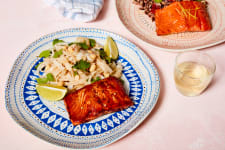When you receive a box of frozen, wild-caught seafood from Wild Alaskan, it should be pretty obvious what needs to happen, right? The short and sweet version of this is to put your seafood in the freezer immediately.
However, we think it’s worth delving into some details that will make you a pro at unpacking and storing your seafood so that you can enjoy it at the peak of its quality.
How to Handle Dry Ice in Your Seafood Box
When you open your box, you’ll see biodegradable insulation surrounding your seafood, which is readily recyclable at the curb; you’ll never see any styrofoam in your shipment. You can set aside these packaging materials for now until your seafood has made its way into the freezer.
We’ve also packed your box with dry ice to keep your seafood frozen. When your package is being prepared for shipment, we make sure to include enough dry ice so that it remains frozen through the end of the day that it is delivered to your doorstep. You may see several blocks of dry ice remaining in your package when you open it, or it may have sublimated (turned from a solid block of ice to harmless vapors of gas). Either way, your seafood should be frozen through. If your seafood is no longer frozen, please reach out to us through our Live Chat module for assistance.
For your safety, please don’t handle the dry ice with bare hands to avoid getting burned as it is extremely cold. If you do still have dry ice left, you can leave it in the box we’ve shipped to you where it will sublimate quickly. Or, if you like a little drama, you can put on some protective kitchen mitts and remove the blocks of dry ice, placing them in a metal vessel. Pour some water on top: You’ll create a spooky, smokey effect that will emanate from your block of dry ice for a few minutes and help it break down more quickly.
Don’t Break the Seal
Until you’re ready to thaw your seafood, don’t break the vacuum-packed seal of each portion’s packaging. We want to make sure that you’re able to enjoy your items at peak quality.
To that end, we recommend that you avoid treating your seafood roughly when you’re moving it from the shipping box to the freezer. Friction from jamming seafood into a tightly-packed shelf, for example, can cause the packaging to lose its seal. Even excessive jostling during shipment can sometimes break the seal of a package as it rubs up against other items. While frozen seafood will be safe to eat indefinitely — regardless of if its packaging is left intact — a broken seal can speed up moisture loss and freezer burn that will noticeably reduce the quality of your products in the long run.
In addition to vacuum-sealed packaging, your seafood may actually have another layer of protection: an ice glaze. Depending on the product, your seafood may seafood be coated during processing with an ice glaze that you’ll notice on its surface. Think of it as a meltaway shield that preserves the integrity of your fish and shellfish. Don’t mistake this for freezer burn. This layer is another line of defense that essentially has locked in the freshness of your seafood from the start.
With all that in mind, your seafood is packed to last. If a seal on one of your packaged portions gets broken, simply note that the quality of the portion inside will degrade more quickly than a perfectly-sealed portion. For reference, we recommend consuming your portions of seafood within 6 months for best flavor and texture; if the vacuum seal has broken on a package, we recommend consuming these portions within a month to enjoy them at the peak of their quality.
Recycle and Reuse
Recycle or reuse the biodegradable and paper-based packaging as you like, collect the plastic-based packaging to be recycled where plastic films are accepted, then anticipate your next wild-caught meal!
How to Thaw Frozen Seafood
When you’re ready to thaw your seafood, we suggest you check out our blog post on how to defrost seafood properly. Doing it the best way requires you to break the seal of its packaging and store it in the refrigerator where it can slowly defrost; its ice glaze will melt away, leaving behind a fresh, ready-to-cook portion of seafood.






